Puerto Madryn
7 January, 2008, 04:51 am in "Argentina"
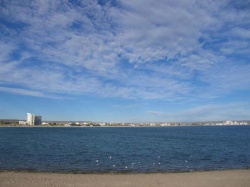 Patagonia is one of those places where I've heard the name often but haven't been entirely sure what was there, aside from mountains as suggested by the logo of the outdoor wear manufacturer. As we traveled, people mentioned going to El Chalten, El Calafate, and Bariloche (Lakes District). I gathered it was a very outdoorsy place with mountains, lakes, glaciers and penguins.
Patagonia is one of those places where I've heard the name often but haven't been entirely sure what was there, aside from mountains as suggested by the logo of the outdoor wear manufacturer. As we traveled, people mentioned going to El Chalten, El Calafate, and Bariloche (Lakes District). I gathered it was a very outdoorsy place with mountains, lakes, glaciers and penguins. A 20 hour bus ride brought us to Puerto Madryn. As we moved south, the main thing we noticed was a beautiful sunset which lasted for quite a while at about 9 or 10 PM.
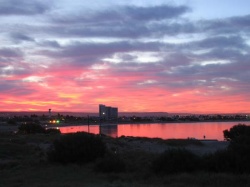
The landscape was flat with scraggly bushes and occasional groups of Guanacos, an Argentinian relative of the Vicuņa which easily blends into the landscape. There were also quite a few sheep which seemed bigger and fluffier than the sheep we'd seen in the Andes. Maybe they were brought over from Wales (a lot of Welsh immigrants settled in this area).
Puerto Madryn is a beach town... not what I was expecting in Patagonia. We got a spot in a crowded campground 3.5 kms south of the town. The town is located on a bay. The campsite was on another part of the bay. During low tide we could cut through the beach and go straight to town rather than follow the curve of the street along the edge of the bay. This reduced the walk substantially. The beach was lined with restaurants and bars. Toward the evening it was so covered with people, we decided to return to the campsite by the road.
The only reason we came to Puerto Madryn was to visit the Valdez Peninsula. I couldn't care less about the beach and we spent most of our time in town hiding from the sun. The Valdez Peninsula is a nature reserve and home of a couple penguin colonies, sea lions, elephant seals and the orcas who love to eat them. The land part is flat with bleak bushes (like the surrounding areas), however we were able to make out a lot more guanacos, ņandus (rheas), and a very cute ground bird with a death wish which we named "stupid birds" due to the fact they seemed to always be trying to get hit by cars (the squirrels of the bird world). Seeing families of ņandus wandering around, fluffing out their feathers and racing at amazing speeds away from the road, proving they were a lot smarter than the "stupid birds" made the long stretches of bleak landscape and gravel roads worthwhile.
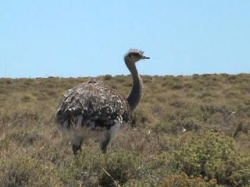
We had rented a car which turned out to be about $20 cheaper than going with a tour. The roads kicked up tremendous amounts of dust and I was extremely grateful that Rowshan loves driving.
From a viewing tower at the visitor center we were able to see the Isla de los Pajaros which inspired the first page of Antoine de Saint-Exupery's "Le Petit Prince" where he described drawing a boa constrictor who swallowed an elephant. The island does resemble the elephant engorged boa constrictor. It also, as with the narrator's drawings, could be easily misinterpreted as a hat.
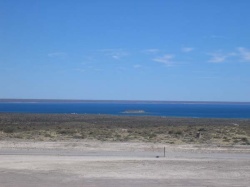
The peninsula is big and the land is harsh. The road had just a few places where one could stop and take in the views, though you could see the sea from the road: bright blue and turquoise.
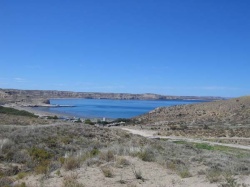
Incidentally, this is the last photo our camera took before it died. The rest of the photos are captured from the video.
Our next stop was an overlook with a view of a long beach covered with elephant seals.
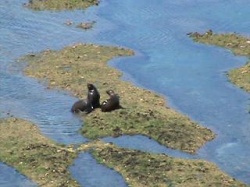
They were big, loud and lounged on the beach like giant slugs. The tide was out leaving a beach area with water filled ridges where the seals were able to swim up to the dry part of the beach.
Caleta Valdez gave us our first glance at Magellanic penguins though there was a bit of a distance between us, we were able to watch a few groups: one group swimming up to a spit, climbing out of the water, walking over the spit, then getting back in the water, swimming a bit around the spit, climbing out again, then diving back in.
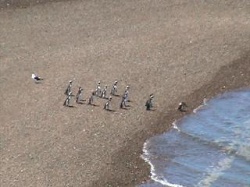
However, this view was nothing compared to the penguin colony which was hanging out a little North of this area. The spot was marked with a sign "pinguinos 200m". We parked our car and walked to the fence expecting to look down at a beach with penguins in the distance. Instead, penguins looked at us from the other side of the fence as if on that side they had a sign reading "Humans 200m." Many had babies (or perhaps the penguin equivalent of teenagers). They were almost the same size as the adults but covered with fluffy gray feathers. The parents groomed them and stood proudly and protectively next to them.
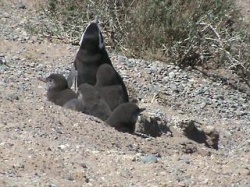
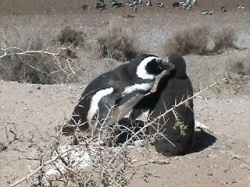
Other penguins seemed to delight in posing for the never ending stream of photographers.
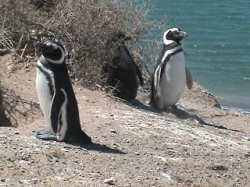
It was hard to leave the penguins but we had to continue on.
Punta Norte was our last stop. This was where the sea lions lived. I'd seen sea lions in San Diego and San Francisco but these were huge and it was understandable why they were called sea lions.
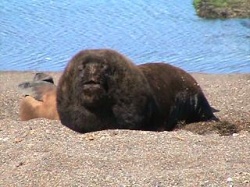
The big males had huge rolls of fat on their neck, big as a lions mane. They roared. The young made the sound of bleating sheep while others seemed to moo like cows. They are definitely not quiet animals. The bulls would occasionally charge each other roaring.
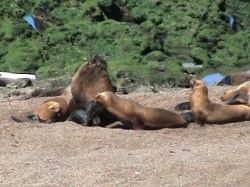
Unfortunately we didn't see any orcas. I think the tide was too low for them to be hunting in that area.
While walking across the parking lot, we saw an armadillo. It turns out that several had burrows in the area.
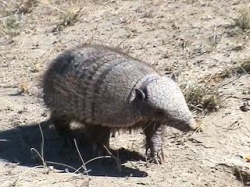
We got back into town around 9PM though it felt more like 5PM. I was having to resign myself to the fact that I was sick (again), but this time with a nasty cold. We had a noisy group move to the campsite next to us. The worst offender was a woman whose voice was gratingly loud who I'm sure I caught telling the others in her group to be quiet because people were trying to sleep. Another site was occupied by 2 screaming kids. Perhaps people are louder than sea lions after all.
Comments
- Comments
Powered by My Blog 1.69. Copyright 2003-2006 FuzzyMonkey.net.
Created by the scripting wizards at FuzzyMonkey.net..
(Code modified by Rowshan Dowlatabadi)
Created by the scripting wizards at FuzzyMonkey.net..
(Code modified by Rowshan Dowlatabadi)

